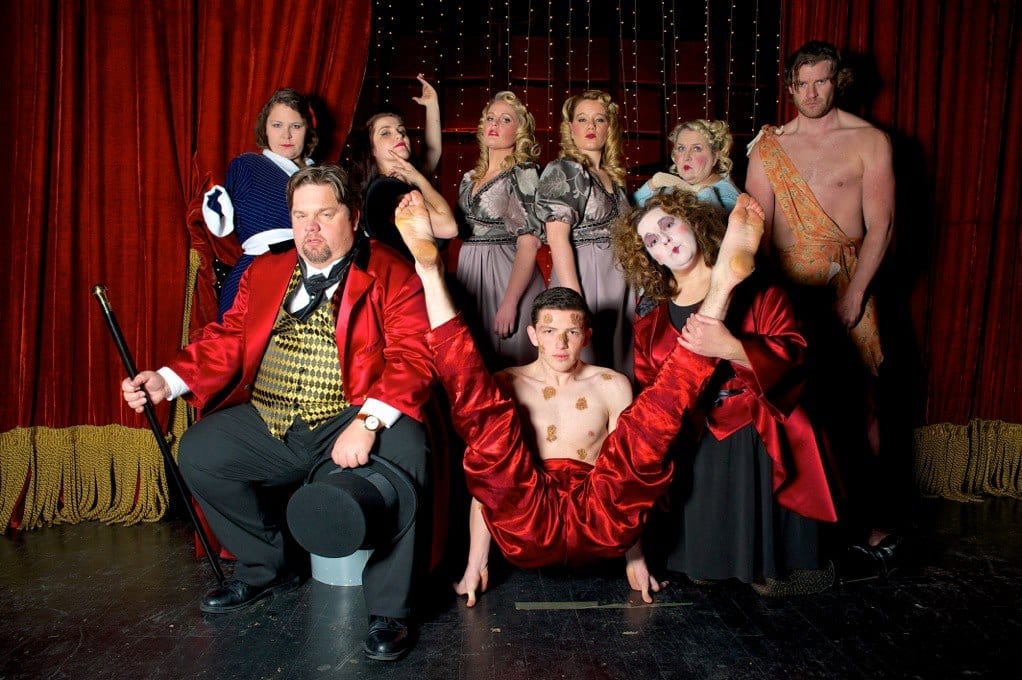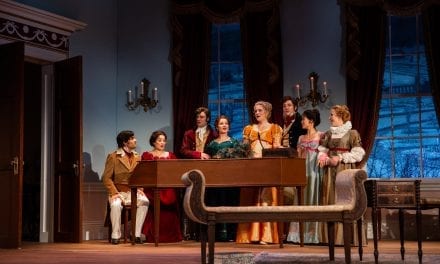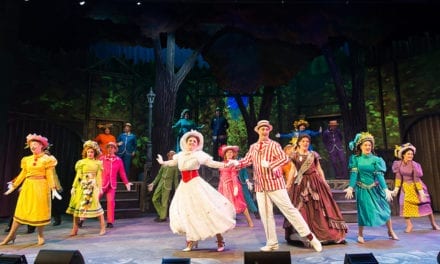PROVO —It is human nature to have one’s attention drawn to something unusual. And nothing quite captures “unusual” like conjoined twins. In an individualistic culture like America’s, the idea of always doing everything with another person is strange, and raises odd questions about everyday tasks and private moments.

Show closes Feburary 2, 2013.
Side Show is the story of two conjoined twins, Daisy and Violet Hilton, who live and work in a circus sideshow in the 1930’s. They encounter a vaudeville manager named Terry Connor (Aleksndr Arteaga) and aspiring performer named Buddy Foster (Taylor Eliason). Buddy teaches the sisters to sing, and Terry and Buddy take them away from the circus to the much more respectable (and remunerative) vaudeville circuit. In time, a complicated web of relationships emerges where Terry likes Daisy, Buddy has feelings for Violet, but Jake (a sideshow performer who accompanies the sisters) is also in love with Violet. The sudden success and fame that the sisters experience only adds stress to the characters’ lives.
The most notable aspect of the production is the performance of Angela Jeffries and Adrien Swenson as conjoined twins Violet and Daisy Hilton, respectively. The two performers not only bear a physical resemblance to each other, but their voices and mannerisms are also so close that it doesn’t take much suspension of disbelief from the audience for Jeffries and Swenson to play sisters. The two also have beautiful and powerful voices that each alone could easily fill a large theatre; together the two are irresistible as they sing songs like “I Will Never Leave You.” “Like Everyone Else” was especially tender, as it established the basic humanity of both characters and helped the audience understand that these “Siamese twins” were completely normal on the inside. Both women were also terribly funny in “Leave Me Alone,” a comedic song which also surprisingly provides insight into their characters’ psychology.

Aleksandr Arteaga, Adrien Swenson, Angela Jeffries, and Cooper Howell.
Taylor Eliason was energetic and fun as Buddy Foster. I enjoyed how the character yearned for fame and a big break in show business, and his duet “More Than We Bargained For” with Arteaga was well executed. Eliason was also excellent at portraying the emotional dilemma that his character had of falling in love with a woman that he could never have for himself. Cooper Howell was an intense Jake, who was useful for adding conflict to a story that would otherwise be a simple story about Violet being forced to choose between a man and her sister. Musically, Howell was most memorable during “The Devil You Know,” which was a classy swing jazz number sung by him and the sideshow freaks. It was unfortunate that Bill Russell’s script neglected his character for large portions of the story.
I was not as pleased by Aleksndr Arteaga’s performance as Terry Connor, which I found wooden. Early on in the show he sings about falling in love with Daisy when he first met her, but in that scene I did not see any indication that Terry had feelings for Daisy. This lack of emotion was also apparent during “Private Conversation.” Connor sang the song well, but failed to show the feelings behind the song and why Terry would sing it.
This production of Side Show features over twenty performers in the ensemble, which might make it the largest cast to ever perform in the Echo Theater. The Side Show ensemble is also distinguished, unfortunately, for being noticeably less satisfying to watch than its five lead actors. With a few exceptions (such as Madeline Weinbergerm), there is a clear chasm between the performing capabilities of the lead actors and the ensemble. For example, Bryan Cardoza (as The Boss) was not very menacing in his scenes in the first act. As a consequence, the supposed danger that Daisy and Violet were facing by leaving his employment wasn’t apparent, which made the scene lack tension and reduced conflict. On the other hand, music director Anne Puzey made the ensemble sound exquisite. The clear diction, rich harmonies, and well balanced sound were a pleasure to hear in “Say Goodbye to the Freak Show” and other songs in the score (composed by Henry Krieger, with lyrics by Bill Russell).
In general, I approve of Johnny Hebda‘s direction of this show. The small Echo stage never felt overcrowded, and the flow from scene to scene was smooth and flawless. Hebda also made the conflict of the story obvious for the audience, which helped me understand who among the five main characters was in conflict with whom and why (which was usually love or financial reasons). I wish Hebda, though, had his actors display more emotion. Because of the subdued performances, I never understood why Buddy or Terry were falling in love with the sisters. Instead, I had to rely on dialogue from the script to get the information, which I found disappointing. I also did not like the social preaching that was clumsily shoehorned into the final song because it did not fit smoothy into the story of Daisy and Violet Hilton.
The choreography (by Howell) was nice, although limited by the small space. The best staged songs were the numbers that were performed by the sisters for other characters (“We Share Everything,” “When I’m by Your Side,” and “One Plus One Equals Three”). These were staged and choreographed in the delightful period style that had me tapping my toes. The song “Tunnel of Love” was also staged very well (although I’m not sure whether that’s to Hebda or Howell’s credit), and helped propel the plot briskly towards the final scene.
Visually, the show has nice with period costumes (especially the spiffy suits for the leading men and glamorous dresses for the twins) provided by Dana Anquoe. The freaks’ costumes were sometimes so odd that I couldn’t not stare, which was certainly the reaction to real sideshow attendees in the past. But I was frustrated when the actors playing circus freaks later played “normal” people but still wore their freak makeup.
Finally, I have to mention the script. Bill Russell has created two excellent characters in Daisy and Violet Hilton. The two are certainly the most three-dimensional characters in the play, and it was a pleasure to spend an evening with them. However, all of the other characters were extremely flat and defined only by either their abnormalities (for the freaks) or their jobs (for the non-freak men). The script is also excruciatingly annoying in how it telegraphs information about characters’ feelings through direct dialogue or music. Of course, having characters sing their emotions is acceptable in musicals. Some of musical theatre’s greatest hits are of characters singing their emotions (“On My Own,” “I Feel Pretty,” “I’m in Love with a Wonderful Guy,” and more). But the script of Side Show lacks any subtext and all emotions are spoon-fed to the audience directly.
Now comes the most difficult part of the review for me: making a final recommendation. There are things I like about this show and things I don’t. It has obvious strengths and glaring flaws. The score contains both charming duets and completely forgettable songs. I probably wouldn’t recommend it to casual theatre-goers. But for those who are tired of the umpteenth production of Annie in their town, the Utah premiere of Side Show may hit the spot.






